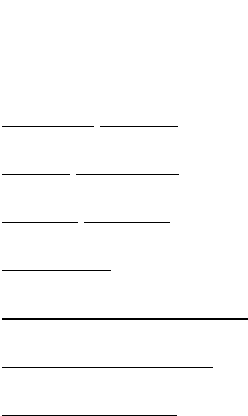Amazon com Services 1496 Electronic Display Device User Manual users guide
Gluteen LLC Electronic Display Device users guide
Contents
- 1. users guide
- 2. Final Users Manual
users guide
User’s
Guide

Table of Contents
Welcome Getting
Started Acquiring
Content Reading
Documents
Maximizing Your Device
Additional Assistance
Legal Information

Welcome
You are reading the Device Overview.
Follow these links to learn more about the most
common tasks on the Device:
• Setting up your Device
• Browsing the Device Store
• Accessing Device Documents
• Managing your Device
• Searching
To see the full contents of this guide, [include
command description]. There’s more assistance
on the Device support website [include
hyperlink], including a printable version of this
overview. Also be sure to look at the
documentation in the Device box.
To keep reading [include command description].
To leave this overview, [include command
description].

Chapter 1
Getting Started
Charging the battery
If you haven’t done so already, please plug your Device into a power source to charge the
battery. A [symbol name] should appear on the battery icon at the top of the [screen
name]. The indicator light will turn yellow while charging and green when the battery is
fully charged. Charging should take less than three hours, and you can continue using the
Device during that time. Charging is faster if you use a AC adapter to plug the Device
directly into a wall outlet instead of charging from a computer via a USB cable.
The Device should only be charged using the USB cable included with the device, or
another USB cable approved for use with the Device, with a compatible USB charger or
USB port that meets the following requirements: [describe requirements]
Using the controls
You need only learn a few simple controls in order to navigate around and use your
Device.
On [location] of the device are the [description of relevant buttons and functionality].
At [location] of the device are a USB port, headphone jack, and [button name] button.
You can use a USB cable to connect your Device to a computer for charging the battery
and transferring files. An AC adapter for the USB cable lets you charge your Device from
a wall outlet.
Setting up your Device
If you’re reading this overview, you’ve probably completed the Device setup process,
which includes choosing a language; connecting to a wireless network; and registering
your Device. If you haven’t done all those steps yet, go to the [screen name] now, select
[document name], and follow the onscreen prompts.
About Wi-Fi connections – Content is delivered directly to your Device via its built-in
Wi-Fi connectivity. You can connect to networks at home, at your favorite cafés, or at
Wi-Fi hotspots around the world. To view all available Wi-Fi networks, from the [screen
name], press the [button name] and select [menu choice]. On the [page name], select
[menu choice] next to Wi-Fi networks.
About registration – If you bought your Device with your Company account, or you’ve
already gone through the Device setup process, the Device is registered and ready to use.

To verify this, press the [button name] and check whether your Company user name is in
the [location] of the [screen name]. If it says “[description]” or shows the name of a
previous owner instead of your own Company account name, you’ll need to register it.
Status Indicators
[provide graphics and descriptions]

Chapter 2
Acquiring Content
Using the Device Store
The online Device Store offers you a broad offering of content. To access the store, select
[menu choice] from any menu.
After purchase, the item is directly delivered to your Device wirelessly.
Managing your Device
The Device can store significant amounts of content. To display a list of content on your
Device, [describe process]. Select the item you want to open, then press [describe
command].
You’ll probably reach a point where you have so many items that you want to group them
for easier access. [describe process]
To delete an item from your Device, [describe process]
If you wish to retrieve content that you’ve deleted, [describe process]. See also “Using
Device with your computer” for more information.
Chapter 3
Accessing Device Documents
Customizing your text display
The Device provides a quick way to adjust the appearance of content. To access those
settings, [describe process] when you’re viewing a document and select [menu option]. A
dialog box will appear that lets you change the way content looks on the Device screen.
You can also change the orientation when you aren’t reading a document, such as from
the [screen name]. Simply press the [button name] and select [menu choice].
Interacting with your documents
Because the Device is a computer, it gives you access to features that aren’t available
with printed materials. You can also [describe functionality].

[Feature Name] – [describe feature].
Search – [describe feature].
[Feature Name] – [describe feature].
[Feature Name] – [describe feature].
[Feature Name] – [describe feature].
[Feature Name] – [describe feature].
When you’re finished
Putting a Device in sleep mode or turning it off when you aren’t viewing content will
allow you to use it longer between battery recharges. You can further conserve battery
life by turning off the wireless connection when not using it.
When you want to stop viewing content, you can let your Device go into sleep mode
automatically after a few minutes, or you can press the power button briefly to initiate
sleep mode immediately. To turn off the device completely, press and hold the power
button for several seconds until the screen goes blank, then release the button.

Chapter 4
Maximizing Your Device
Customizing your Device settings
To go to the [page name], select [menu choice] from the [screen name]. The options on
this page are: [describe options].
The Settings contextual menu
When you’re on the [page name], the menu offers some important functions that aren’t
available from the [screen name] or content menus.
Update Your Device – Installs the latest software for your Device. If there are currently
no software updates available on your Device, this option is [describe].
Restart – Restarts your Device.
Reset to Factory Defaults – Resets your Device to its original factory settings and
restarts it. You should only select this action if instructed to do so by Customer Service.
Before you reset your Device to factory defaults, you must back up certain content. Once
your Device restarts, you must create a new device password if you want to continue to
password-protect your Device.
Legal – Provides trademark, copyright, and other notices about the software installed on
your Device.
Viewing other types of files
Device can display a PDF document without losing the formatting of the original file.
Just drag the PDF file to [location] on your Device via a USB connection, or [describe
additional option].
Sharing via social networks
You can connect with friends using social networks and share your thoughts.
[Describe feature]
[Describe feature]

Using the Device with your computer
By connecting your Device to your computer via a USB cable, you can add content to the
Device without a Wi-Fi connection. Your Device will work with any computer running
Mac OS X 10.2 or later, or Windows 2000 or later.

Web
The Device support website has a wealth of information and assistance, including how-to
videos. Topics include:
• Troubleshooting
• Shopping for content
• Organizing content
• Traveling with the Device
• and many more…
You’ll find the Device support website at:
[include URLs]
E-mail
[include e-mail addresses]
Telephone
[include telephone numbers]

Appendix A
Legal Information
FCC Compliance Statement
The Devices comply with part 15 of the FCC rules. Operation is subject to the following two
conditions: (1) The Device may not cause harmful interference; and (2) this Device must
accept any interference received, including interference that may cause undesired
operation.
The Devices have been tested and found to comply with the limits for a Class B digital
device, pursuant to part 15 of the FCC rules. These limits are designed to provide
reasonable protection against harmful interference in a residential installation. However,
there is no guarantee that interference will not occur in a particular installation.
The Devices meet the FCC Radio Frequency Emission Guidelines and are certified with
the FCC as the FCC ID number found on the back of the Device.
Changes or modifications not expressly approved by the party responsible for compliance
could void the user's authority to operate the equipment.
Information Regarding Exposure to Radio Frequency Energy
Your Device is designed and manufactured not to exceed the emission limits for exposure
to RF energy set by the Federal Communications Commission of the United States (FCC).
Information on your Device is on file with the FCC and can be found under the Display
Grant section of http://transition.fcc.gov/oet/ea/ after searching on the FCC ID for your
Device, which can be found on the back of the Device.
Canadian Compliance Statement
This device complies with the Canadian ICES-003 Class B specifications.
Cet appareil numérique de la Classe B est conforme à la norme NMB-003 du Canada.
This device complies with RSS 210 of Industry Canada. This Class B device meets all the
requirements of the Canadian interference-causing equipment regulations.
Cet appareil numérique de la Classe B respecte toutes les exigences du Règlement sur le
matériel brouilleur du Canada.
This device complies with Industry Canada license exempt RSS standard(s). Operation is
subject to the following two conditions: (1) this device may not cause interference, and (2)

this device must accept any interference, including interference that may cause undesired
operation of the device.
Cet appareil est conforme aux normes CNR exemptes de licence d’Industrie Canada. Le
fonctionnement est soumis aux deux conditions suivantes : (1) cet appareil ne doit pas
provoquer d’interférences et (2) cet appareil doit accepter toute interference, y compris
celles susceptibles de provoquer un fonctionnement non souhaité de l’appareil.
This device is compliant with general population/uncontrolled RF exposure limits in IC
RSS-102
Cet appareil est conciliant avec les limites d'exposition de RF population/non contenu
générales dans IC RSS-102